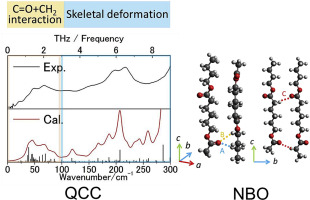Polymer ( IF 4.1 ) Pub Date : 2018-01-09 , DOI: 10.1016/j.polymer.2018.01.025 Chihiro Funaki , Shigeki Yamamoto , Hiromichi Hoshina , Yukihiro Ozaki , Harumi Sato

|
The long range structure of poly(ε-caprolactone) (PCL) has been studied by terahertz (THz) spectroscopy, infrared (IR) spectroscopy and quantum chemical calculations (QCCs). Natural bond orbital (NBO) analysis and the calculation of the interatomic distances between C-H and O=C groups in PCL crystalline indicate that the PCL chain has three kinds of weak intermolecular interactions between the CH2 and C=O groups. In the IR spectra, significant changes due to the influence of hydrogen bondings were observed in the CH2 and C=O stretching vibration regions. The results of QCCs performed by using the Cartesian Coordinate Tensor Transfer (CCT) method to assign the THz spectra of PCL suggest that the peaks at 47 and 67 cm−1 reflect the atomic motions of the C=O + CH2 moiety derived from the weak C-H⋯O=C hydrogen bondings. THz spectroscopy allows us to observe the intermolecular hydrogen bondings of the polymer separately, since hydrogen bondings with different strengths yield different peaks in a THz spectrum. The results of THz and IR spectral analysis, and QCCs all indicate that PCL forms three kinds of weak intermolecular C-H⋯O=C hydrogen bondings between the CH2 and C=O groups. This may be one of the causes for the low melting temperature but high crystallinity of PCL. There are about six interactions in PCL and about sixteen interactions in polyglycolic acid (PGA), within the lamellar thickness. Therefore, it is suggested that the difference in the number of intermolecular interactions within the lamellar thickness leads to the difference in melting points between the two polymers.
中文翻译:

用太赫兹光谱,红外光谱和量子化学计算研究了聚(ε-己内酯)中三种不同类型的弱CH⋯O = C分子间和分子内相互作用
聚(ε-己内酯)(PCL)的远距离结构已通过太赫兹(THz)光谱,红外(IR)光谱和量子化学计算(QCC)进行了研究。自然键轨道(NBO)分析和PCL晶体中CH和O = C基团之间的原子间距离的计算表明,PCL链在CH 2和C = O基团之间具有三种弱的分子间相互作用。在IR光谱中,在CH 2和C = O拉伸振动区域中观察到由于氢键的影响而引起的显着变化。通过使用笛卡尔坐标张量传递(CCT)方法分配PCL的THz光谱执行的QCC结果表明,在47 cm -1和67 cm -1处的峰反映了源自弱CH = O = C氢键的C = O + CH 2部分的原子运动。太赫兹光谱使我们能够分别观察聚合物的分子间氢键,因为具有不同强度的氢键会在太赫兹光谱中产生不同的峰。太赫兹和红外光谱分析结果以及QCC均表明PCL在CH 2之间形成了三种弱分子间CH⋯O = C氢键和C = O基团。这可能是PCL熔化温度低但结晶度高的原因之一。在层状厚度内,PCL中约有六种相互作用,聚乙醇酸(PGA)中有约十六种相互作用。因此,建议层状厚度内的分子间相互作用数的差异导致两种聚合物之间的熔点差异。









































 京公网安备 11010802027423号
京公网安备 11010802027423号